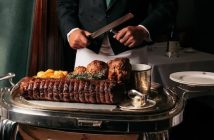I’m a big advocate of fun dining. I don’t mean medieval banquets, wooden spoons and waiters in lederhosen and sombreros, but dining that subtly embraces a sense of place, of theatre. And with a name like German Gymnasium, one can’t help but think there’ll be something spectacular to be had.
And, indeed, there is. The last time I exited King’s Cross station after 7 at night, I was skittish and twitchy, suspicious of anyone who came within arm’s reach. It was the sort of place about which we used to make jokes at school at the expense of friends’ mothers. But a lot can change in a decade. Instead of graffiti’d weather boarding hiding derelict brownfield, there’s a piazza to cross to a Grade II-listed building I never knew existed, even though it’s been there for over a hundred years. This is the eponymous German Gymnasium. And it’s not a cute, funky name to suit a five-minute dining vogue, it genuinely was a gymnasium. For Germans.
Inside, there’s there’s much to marvel at; the room, for one – it’s gargantuan. Historically, it served as a training venue for the German Olympic team in the late 19th century, then a certain spat between royal cousins got in the way around 1914 and our Teutonic peers vacated. It was, curiously, conjoined amid other buildings during the area’s hideous middle years of the 20th century, remaining only by virtue of its impressive interior and saved from demolition because the local authorities thought that one day it might be restored. And it has been.

Whether you’re dining around the mezzanine or on the main floor below, your view is big and bold. Huge arched cast iron beams straddle the ceiling, detailed capitals on Corinthian columns surround the balcony; even original artefacts from its days as a gymnasium still exist, preserving its heritage. This, readers, is theatrical dining at its finest.
The building’s only half the fun, however. The place buzzes. Helped ably by the Meister bar with an enviable cocktail list, full of canny turns itself throwing one into the evening; my signature ‘Haig Club’ was served with its own bit of theatre, all smoke and mirrors – that’s not a euphemism – as it was poured from a shiny branded hip flask. The service is slicker than a Saxon’s sideburns but we’re not rushed; at our time, we’re ushered to our table, one of the enviable spots on the mezzanine overlooking the main floor below. As dining ventures go for Larman and I, this was one we’d been looking forward to.

And so far, so glorious. But why do you get the sense there’s a big ‘but’ coming? Well, there is. You see, it’s a wonderful setting, the service is impeccable, you’re paying for the experience, the room, the history, and that spectacular bar, but, sadly, what let’s it down is the food.
The presence of schnitzels and bratwurst are not the issue – after all, that’s why we were there, I was counting on the authenticity – but since it handles some 200 covers a night (on average – at capacity it’s 450) like any banquet it feels a little ‘production line’. Our starters, for example, arrived with suspicious speed. The crab cake showing sibling connections to those deep fried fishcakes that come in frozen bags of fifty before being submerged in a deep fat fryer. To their credit, the flavour was all there, if not the crab, and it was complimented by a pleasant choice from the sommelier.
The wine, I should add, is another boon for the Gym, and the sommelier’s understanding of their German wines was an education. For the crab cake, my instinctive draw for the Riesling was matched only by the restaurant’s extensive collection. When it came to our mains, sticking with a good thing, it was a Baden pinot noir from the same producer, Schneider.
The wines, then – faultless, ambrosial – became the main event to what accompanied them, rather than the opposite. Sticking to the theme, we opted for a sharing main, a Teutonic tradition: Tafelspitz. With a name like a WW1 dreadnought, it would require the constitution of one to sink it, too. A large ceramic tureen was presented nobly before us, and we leaned in with eagerness, spoons at the ready. The lid was lifted, and our hearts sank. If Tafelspitz were, indeed, a naval battleship, then we were met with the contents of its bilge bay. Larman stirred the pot, and introduced Austria’s national dish: boiled beef and sausage in a watery, silt-coloured broth. We chewed on overpriced leather for the best part of half an hour. ‘The sausage isn’t bad,’ Larman offered, by way of recompense.

Things improved once more with the arrival of, naturally, the apple strudel, and a honey-coloured Beerenauslese from Wachau. Sticky and candy-like, it puckered the mouth and worked off the acidity of the apple delightfully. It was, however, a dashed too little too late, and we parted with expectations somewhat deflated. The experience was not unlike a spectacular Christmas in all other respects but where one can’t hide the disappointment of getting the wrong gift.
In fairness, our Germanic friends are not known for their cuisine generally – I say generally because some of the finest meals I’ve had have been in Berlin and Bavaria – but, as a rule, it’s meaty, fatty, starchy and stodgy. And that’s all part of the experience. The building may date back to 1865 and, it would seem, so does the catering.
Perhaps that’s what makes the German Gymnasium suitably authentic.
The German Gymnasium, 1 King’s Boulevard, London N1. For more information, including a wonderfully detailed history of the building, visit www.germangymnasium.com.
This summer, the German Gymnasium is teaming up with roaming Berlin pop-up, Brunch, to bring the ultimate Berlin brunch experience to London. From now until 17th July, every Saturday and Sunday Londoners can tuck into KX currywurst, fleischsalat, a selection of cheeses, meats and smoked fish, and bread from Germany’s leading bakery, Kamps. To reserve a table, visit the website.




